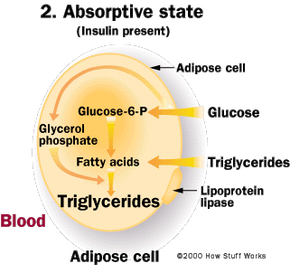Fat Storage
In the last section, we learned how fat in the body is broken down and rebuilt into chylomicrons, which enter the bloodstream by way of the lymphatic system.
Chylomicrons do not last long in the bloodstream -- only about eight minutes -- because enzymes called lipoprotein lipases break the fats into fatty acids. Lipoprotein lipases are found in the walls of blood vessels in fat tissue, muscle tissue and heart muscle.
Advertisement
Insulin
When you eat a candy bar or a meal, the presence of glucose, amino acids or fatty acids in the intestine stimulates the pancreas to secrete a hormone called insulin. Insulin acts on many cells in your body, especially those in the liver, muscle and fat tissue. Insulin tells the cells to do the following:
- Absorb glucose, fatty acids and amino acids
- Stop breaking down glucose, fatty acids and amino acids; glycogen into glucose; fats into fatty acids and glycerol; and proteins into amino acids
- Start building glycogen from glucose; fats (triglycerides) from glycerol and fatty acids; and proteins from amino acids
The activity of lipoprotein lipases depends upon the levels of insulin in the body. If insulin is high, then the lipases are highly active; if insulin is low, the lipases are inactive.
The fatty acids are then absorbed from the blood into fat cells, muscle cells and liver cells. In these cells, under stimulation by insulin, fatty acids are made into fat molecules and stored as fat droplets.
It is also possible for fat cells to take up glucose and amino acids, which have been absorbed into the bloodstream after a meal, and convert those into fat molecules. The conversion of carbohydrates or protein into fat is 10 times less efficient than simply storing fat in a fat cell, but the body can do it. If you have 100 extra calories in fat (about 11 grams) floating in your bloodstream, fat cells can store it using only 2.5 calories of energy. On the other hand, if you have 100 extra calories in glucose (about 25 grams) floating in your bloodstream, it takes 23 calories of energy to convert the glucose into fat and then store it. Given a choice, a fat cell will grab the fat and store it rather than the carbohydrates because fat is so much easier to store.
Next, we'll look at how your body breaks down fat.
